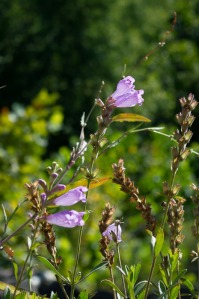Virginia bugleweed, aka Virignia water-horehound (and a host of other common names)
Lycopus virginicus
Lamiaceae
The last photo in yesterday’s post showed most of a single boneset, with a few other plants to its left – plants with small white flowers. They didn’t really register the day I took that photo. It was my first time out in a kayak with a camera (an ancient point-and-shoot with very low resolution), and I wasn’t able to maneuver close to the plants, and anyway I was totally focused on the boneset leaves.
So much for excuses. I was looking at the picture on the computer and thought “what in the world…?” So I went back with a better camera (cleverly though cumbersomely packed to keep it dry) and got better pictures.
But not great pictures. I was still unable to maneuver close to the plants, and the water was choppy, making it exceptionally difficult to keep the camera still.
It was quick work to get to the genus Lycopus, but I’m still not sure the species is correct. With help from the Maryland Biodiversity website I narrowed it down to three. Cross-checking with the excellent, detailed dichotomous key at gobotany.com didn’t help much, because I didn’t have enough or the right details in the pictures. And the Illinois Wildflowers site, one of my go-to resources, offered some contradictory information.
One thing I did learn: this is considered a tricky genus.
At any rate, the bugleweeds/water horehounds are wet soil lovers (as is everything I’ve found growing in the lower Potomac Gorge). This one ranges from the Atlantic coast as far west as Texas and Minnesota. It’s threatened in Michigan.
Why “Lycopus“? Beats me. The lower leaves of some of the species are sharply lobed (more so than this one). Perhaps someone thought they looked like a wolf’s foot. Common names tell us more about the name-givers than about the plants.
UPDATE 12/30/16: I am virtually certain, after much study, that I got it wrong. This one is northern bugleweed, Lycopus uniflorus.



















